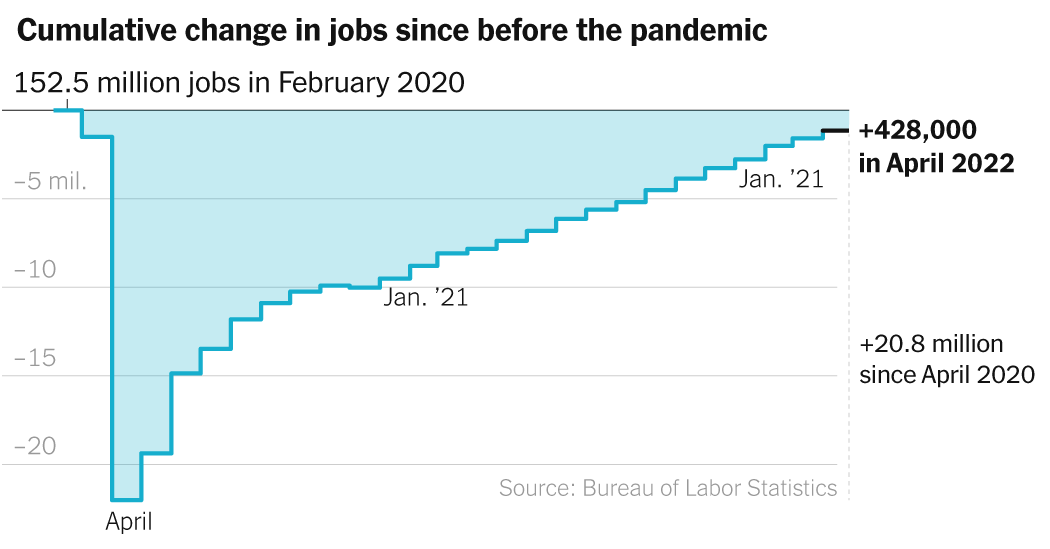
The U.S. economic rebound from the pandemic’s devastation held strong in April with another month of solid job growth.
Employers added 428,000 jobs, matching the previous month, the Labor Department reported Friday, with the growth broad-based across every major industry.
The unemployment rate remained 3.6 percent, just a touch above its level before the pandemic, when it was the lowest in half a century.
The challenge of a highly competitive labor market for employers — a shortage of available workers — persisted as well. In fact, the report showed a decline of 363,000 in the labor force.
The economy has regained nearly 95 percent of the 22 million jobs lost at the height of coronavirus-related lockdowns two years ago. But the labor supply has not kept up with a record wave of job openings as businesses expand to match consumers’ continued willingness to buy a variety of goods and services. There are now 1.9 job openings for every unemployed worker.
The hiring scramble has driven up wages, and employers are largely passing on that expense, helping fuel inflation that Americans have cited as their leading economic concern. On that front, Friday’s report showed an easing in the acceleration of average hourly earnings, which increased 0.3 percent from the month before, after a 0.5 percent gain in March.
President Biden pointed to the latest data as evidence of “the strongest job creation economy in modern times,” a message the White House is increasingly amplifying ahead of the congressional elections.
But a record share of Americans now rate inflation as the biggest financial problems facing their households, according to a Gallup Poll in April. The survey found that 46 percent of Americans rated their personal finances positively, down from 57 percent last year, when most households were freshly benefiting from rounds of direct federal aid.
After the Labor Department report on Friday, Ronna McDaniel, the chairwoman of the Republican National Committee, put the spotlight on inflation rather than jobs. “Families can’t afford food and groceries, wages can’t keep up with inflation, and Biden’s agenda is only going to make it worse,” she said in a statement.
The State of Jobs in the United States
The U.S. economy has regained more than 90 percent of the 22 million jobs lost at the height of pandemic in the spring of 2020.
- April Jobs Report: U.S. employers added 428,000 jobs and the unemployment rate remained steady at 3.6 percent in the fourth month of 2022.
- Trends: New government data showed record numbers of job openings and “quits” — a measurement of the amount of workers voluntarily leaving jobs — in March.
- Job Market and Stocks: This year’s decline in stock prices follows a historical pattern: Hot labor markets and stocks often don’t mix well.
- Unionization Efforts: Since the Great Recession, the college-educated have taken more frontline jobs at companies like Starbucks and Amazon. Now, they’re helping to unionize them.
The April survey showed average hourly earnings 5.5 percent higher than a year earlier, but with inflation running at 6.6 percent — its highest rate in 40 years — workers are being left with reduced purchasing power.
Rapid price increases, which began last spring as demand from households and businesses collided with a chaotic reordering of the supply of goods and labor, have persisted longer than the Federal Reserve expected, prolonged in part by the price pressures stemming from the war in Eastern Europe and lockdowns in China.
As a result, the Federal Reserve announced this week that it would raise its benchmark interest rate by half a percentage point — the biggest increase since 2000 — and signaled that additional increases are coming. The effort aims to slow demand and business expansion by making money more expensive to borrow, with the goal that this could, in turn, slow down hiring and decrease job seekers’ ability to vie for higher wages.
If borrowing costs reach what officials call restrictive levels, a recession and a reversal of job gains could follow. But the Fed chair, Jerome H. Powell, has expressed confidence that the economy can be steered back into balance, a view some economists have echoed.
“Job creation will eventually settle into a slower pace as businesses feel the pinch of soaring inflation and tighter financial conditions, but gains will stay healthy,” said Oren Klachkin, a lead U.S. economist at Oxford Economics. He forecast that the economy, which has added two million jobs in 2022, would add another two million by year’s end.
In any case, the economic effects of the Fed’s intervention won’t play out overnight, and there are reasons to think the process could take longer than in the past. “Right now we’re not seeing any meaningful signs that consumers or businesses are pulling back,” Mr. Klachkin said. “Sentiment might be weak out there, but that doesn’t always indicate how people spend their money. In other words, people feel one way, but are acting another.”
A major force upholding business expansion and job growth has been the durability of household finances, buoyed by the relief spending of the past two years. Savings accumulated during the pandemic, though tilted toward the affluent, remain in the trillions. And according to anonymized data collected by Bank of America, which tracks the spending of its 67 million customers, households with an annual income below $50,000 have about twice the savings they did before the pandemic.
Mary and Chris Ginder, a married couple in St. Charles, Ill., who run a business making artisanal hot sauces, have seen the benefits of the continued willingness to spend.
They were pleased with their growing operation, Spice of Life, in February 2020. Then came a problem: “About 45 percent of our business consisted of going around to local festivals and farmers’ markets, getting face to face with people and selling direct to customers,” Ms. Ginder said. That business model was fully undermined by virus fears and the state’s health restrictions.
To keep the business alive, the couple pivoted to free delivery and aggressively increased their e-commerce presence by refurbishing their website, marketing by email and doing social media campaigns with local partners. When gasoline prices surged, they canceled the free delivery service.
“We tried to see it as an opportunity, you know? It’s not all negative.” Mr. Ginder said, referring to the vagaries of the past two years. “For everything that seems like a hiccup, there’s something positive that can come out of it, if you’re creative enough.”
With weekend markets and festivals running again, the couple has enough cash flow to expand beyond their eight to 10 employees. So far, they have not had trouble hiring. Part-time kitchen workers start at $12 an hour, and pay for full-time workers varies greatly based upon negotiation.
“We’ll come up with a wage that makes sense for them and for us,” Ms. Ginder said. “Even if it means sort of stretching our pocket a little bit, because we see the big picture with them.”
Other employers have found it harder to manage the current environment. Jerry Bone, the owner of West Side Electric Service in Nashville, has eight electricians on staff. Yet he says he could use more.
“It’s hard to get any young people to even train,” he complained, before asserting that there have been times when he has trained new hires only to see how “a guy can spin off you” — quickly start his own business — “then call your customers up.” Frustrated, he characterized the trend as part of what sees as an impatient expectation among a younger generation of tradesmen “to start off on the top of the pay scale” in a way that erodes teamwork.
With business orders booming in the area, he said, veteran electricians like him, “who can do it — they’re in demand.” He would prefer to hire more and focus on management and training, he added, but the staffing shortage keeps him in the field until the evening six days a week. “I’m 68 years old, still working with my tools, climbing in attics,” he said.
This all comes, Mr. Bone says, on top of head-spinning increases in the price of electrical components — “coils, circuit boards, even some circuit breakers” — which are also often in short supply. “I mean, one circuit breaker that was $28 is now $108.”As a result, he has increased prices. “Our customers are not liking it at all,” he said.
While a growing number of economists believe the country is at or near full employment, in which virtually all who are able and willing to work are doing so, the consulting firm McKinsey concluded in a recent report that the “untapped” labor pool — those who are not in the work force, but who might return with the right offer and under the right conditions, such as relief from caregiving obligations — could be as large as 23 million people.
Even if the labor force returned fully to its prepandemic level, there wouldn’t be enough workers to meet employers’ needs, said Michelle Meyer, chief U.S. economist for Mastercard.
“It’s not about getting supply to where it was prepandemic,” she said. “It’s about getting supply to meet this very high level of demand.”
Ben Casselman, Zolan Kanno-Youngs and Jeanna Smialek contributed reporting.




